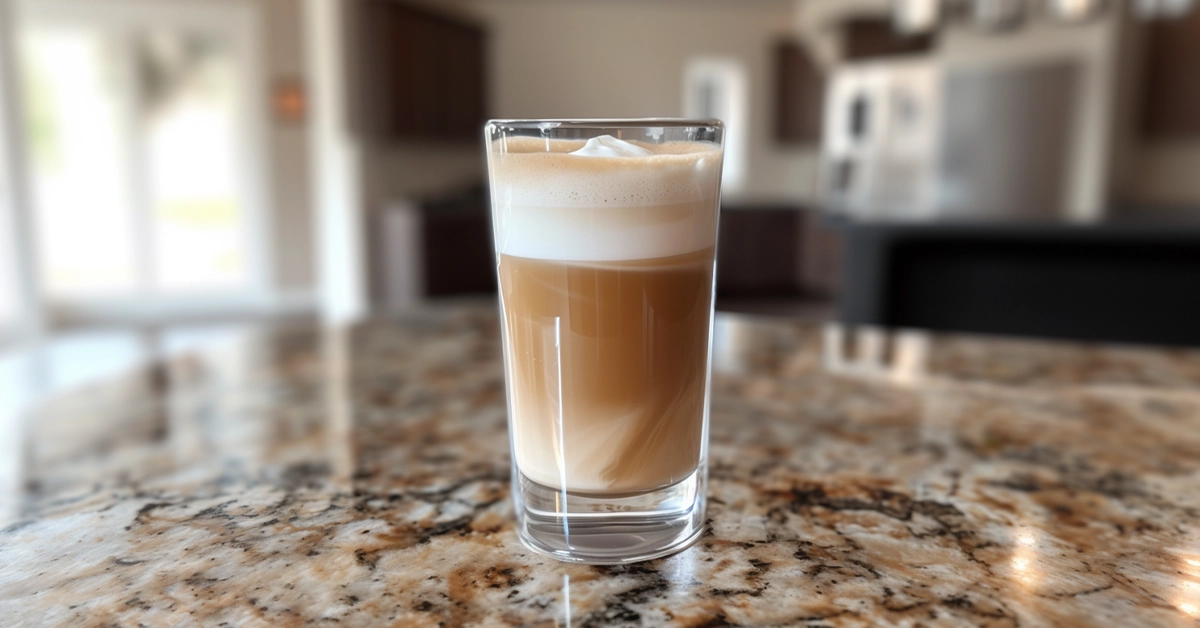Are you looking to add a touch of café sophistication to your morning coffee routine? The Latte Macchiato, with its inviting layers of frothy milk, rich espresso, and a topping of airy foam, offers just that.
This guide on How to Make Latte Macchiato is designed for coffee lovers at any skill level, from beginners to seasoned home baristas, looking to master the art of making a Latte Macchiato at home. By the end of this post, you’ll not only know how to make latte macchiato but also understand the nuances that make it so special.
What exactly is a Latte Macchiato?
Unlike a traditional latte, the Latte Macchiato starts with steamed milk and is then “marked” with a shot of espresso. This method results in a striking visual contrast between the milk and the coffee, with the espresso gently resting between the milk and foam layers. Understanding this drink’s composition and the balance of its ingredients is key to perfecting it at home.
Macchiato vs. Latte Macchiato: Understanding the Difference
While both drinks share core ingredients, they differ significantly in preparation, taste, and presentation.
- Macchiato: A traditional Macchiato is a shot of espresso “stained” with a splash of milk, offering a strong espresso flavor with a hint of milkiness.
- Latte Macchiato: Inverts the ratio, featuring steamed milk “stained” with espresso, resulting in a milder flavor that highlights the milk with an espresso accent.
Ingredients Needed
👉🏼 Espresso
The quality of your espresso can make or break your Latte Macchiato. Consider using freshly ground beans from your favorite coffee roaster for the best flavor. For more insights, check out our blog post on the best coffee for espresso.
👉🏼 Milk
Whole milk is recommended for its fat content, which lends to a creamier texture and more stable foam. However, milk alternatives can also be used.
Milk frothiness hinges on the fat content; whole milk is traditionally used for creating rich, smooth foam.
However, you have options if you prefer lower-fat alternatives or non-dairy products:
- Whole milk: Produces the best froth due to its higher fat content.
- 2% milk: A compromise between full-fat and skim, it gives a satisfactory froth with less richness.
- Oat milk: Stands out among non-dairy options for its superior froth and creamy texture.
| Milk Type | Fat Content | Frothing Quality |
|---|---|---|
| Whole milk | High | Rich and creamy |
| 2% milk | Moderate | Satisfactory |
| Oat milk | Low/Varies | Non-dairy favorite |
Tools Needed
👉🏼 Espresso Machine
A machine with a reliable steam wand is ideal. If you don’t have an espresso machine, a strong brewed coffee from a Moka pot or Aeropress can work as a substitute.
Pros
- Compact Design: Ideal for small kitchens or apartments, the compact size ensures it fits seamlessly into limited spaces without compromising functionality.
- Automatic Milk Frother: Offers convenience with an automatic milk frother function, delivering perfectly textured milk for lattes and cappuccinos without manual effort.
- Quick Heating: Heats up rapidly, allowing you to prepare your morning coffee swiftly and efficiently, saving valuable time during busy mornings.
Cons
- Small Water Tank: The water tank's limited capacity may require frequent refilling, especially when making multiple drinks, which could be inconvenient for some users.
👉🏼 Steam Wand or Milk Frother
Essential for creating the frothy, airy milk that’s a hallmark of a great Latte Macchiato.
👉🏼 Tall Glass
The visual appeal of a Latte Macchiato is best appreciated in a clear, tall glass that showcases its beautiful layers.
Step-by-Step Guide to Making a Latte Macchiato

Creating a Latte Macchiato, which means “stained milk” in Italian, involves precision and care to achieve its signature layers. Follow this step-by-step guide to craft the perfect Latte Macchiato at home:
- Prepare Your Espresso
- Start by grinding your coffee beans to a fine consistency, typical for espresso.
- Tamp the grounds firmly to ensure an even and compact layer.
- Brew a single or double shot of espresso, depending on your preference. Remember, one shot is typically 25 milliliters (about 0.84 ounces).
- Steam the Milk
- While the espresso is brewing, begin steaming your milk until it reaches a creamy consistency with small, fine bubbles. This creates a velvety texture that’s crucial for a Latte Macchiato.
- The ideal temperature for steamed milk is around 65°C (149°F), which keeps it hot but not scalding, preserving its natural sweetness. You’ll need about 150-200 milliliters of milk.
- Layer the Drink
- Pour the steamed milk into a tall glass, filling it about two-thirds full. Allow the milk to settle for a moment.
- Carefully pour the hot espresso shot over the back of a spoon or a special pouring device directly through the center of the foam. This technique helps distribute the coffee gently, allowing the espresso to float on top and create a beautiful gradient between the milk and coffee.
- Aim for the espresso to sit between the milk and foam layers, creating the characteristic “stain” or macchia, which gives the Latte Macchiato its name.
- Finishing Touches
- Add a dollop or two of milk foam on top to add texture and complete the beverage.
Remember, the key to a successful Latte Macchiato is patience and precision, ensuring each layer maintains its integrity and contributes to the overall flavor and presentation of the drink. Enjoy your perfectly crafted Latte Macchiato!
Tips and Tricks for the Perfect Latte Macchiato
- Temperature Control: Monitoring the temperature of both the espresso and the milk is crucial. Overheated milk loses its sweetness, and too-cool espresso can alter the flavor balance.
- Pouring Technique: Pouring the espresso slowly and at the right height can dramatically affect the layering. A spoon or a small pitcher can help control the flow.
Advanced Tips and Tricks
- Flavor Variations: Experiment with syrups or spices, adding them either to the milk before steaming or directly into the espresso. Vanilla, caramel, and cinnamon are popular choices.
- Latte Art: For those looking to challenge themselves further, latte art can be attempted by carefully pouring the milk and using a tool to shape the foam.
Common Mistakes to Avoid
- Wrong Milk Temperature: Milk that’s too hot can scald, affecting its taste and ruining the texture necessary for proper layering.
- Incorrect Espresso Strength: An espresso that’s too weak will blend into the milk without creating a clear layer, while one that’s too strong can overpower the delicate balance of flavors.
Latte Macchiato vs. Other Coffee Specialties

When you’re navigating the world of coffee, it’s easy to get confused by the variety of options available. Let’s compare the latte macchiato with a couple of other coffee staples:
- Latte (Caffè Latte): While both the latte and latte macchiato contain milk and espresso, in a traditional latte, the espresso is poured first followed by steamed milk and a small amount of foam.
- Cappuccino: Differing primarily in proportions, a cappuccino has equal parts espresso, steamed milk, and milk foam, resulting in a stronger coffee flavor and a cooler temperature due to the higher ratio of foam.
International Latte Macchiato Variations
Each region has its twist on the Latte Macchiato, introducing new flavors and preparation techniques.
| Country | Variation | Flavor Note |
|---|---|---|
| Italy | Marocchino | Cocoa powder on top |
| Germany | Pharisäer | Addition of rum |
| America | Caramel Macchiato | Extra caramel syrup layer |
Discovering these international variations can inspire you to blend traditional recipes with modern flavors, creating a Latte Macchiato that’s uniquely yours.
Remember, the key to a great experience is balancing the added flavors with the coffee’s natural profile.
💡This might also interest you
Explore our blog post on the difference between an espresso and a macchiato.
FAQ – How To Make Latte Macchiato
What’s the difference between a macchiato and a latte?
A macchiato primarily consists of espresso with a small amount of milk foam, while a latte combines espresso with more steamed milk and a light layer of foam.
What is stronger a latte or a macchiato?
A macchiato typically has a stronger coffee flavor, as it contains less milk than a latte, allowing the taste of the espresso to be more pronounced.
What makes a latte macchiato?
A latte macchiato is characterized by layers of steamed milk, espresso, and milk foam. The key is to pour the espresso slowly into the milk, creating a distinct marbling effect.
What are the proportions of a latte macchiato?
A classic latte macchiato involves a ratio of one shot of espresso to about 150-200 milliliters of steamed milk and 1-2 dollops of milk foam. The steamed milk is layered with the espresso carefully poured in the middle, followed by a top layer of foam.
If you liked our blog post on the topic “How To Make Latte Macchiato”, don’t forget to leave us a comment down and share your thoughts on this topic.





